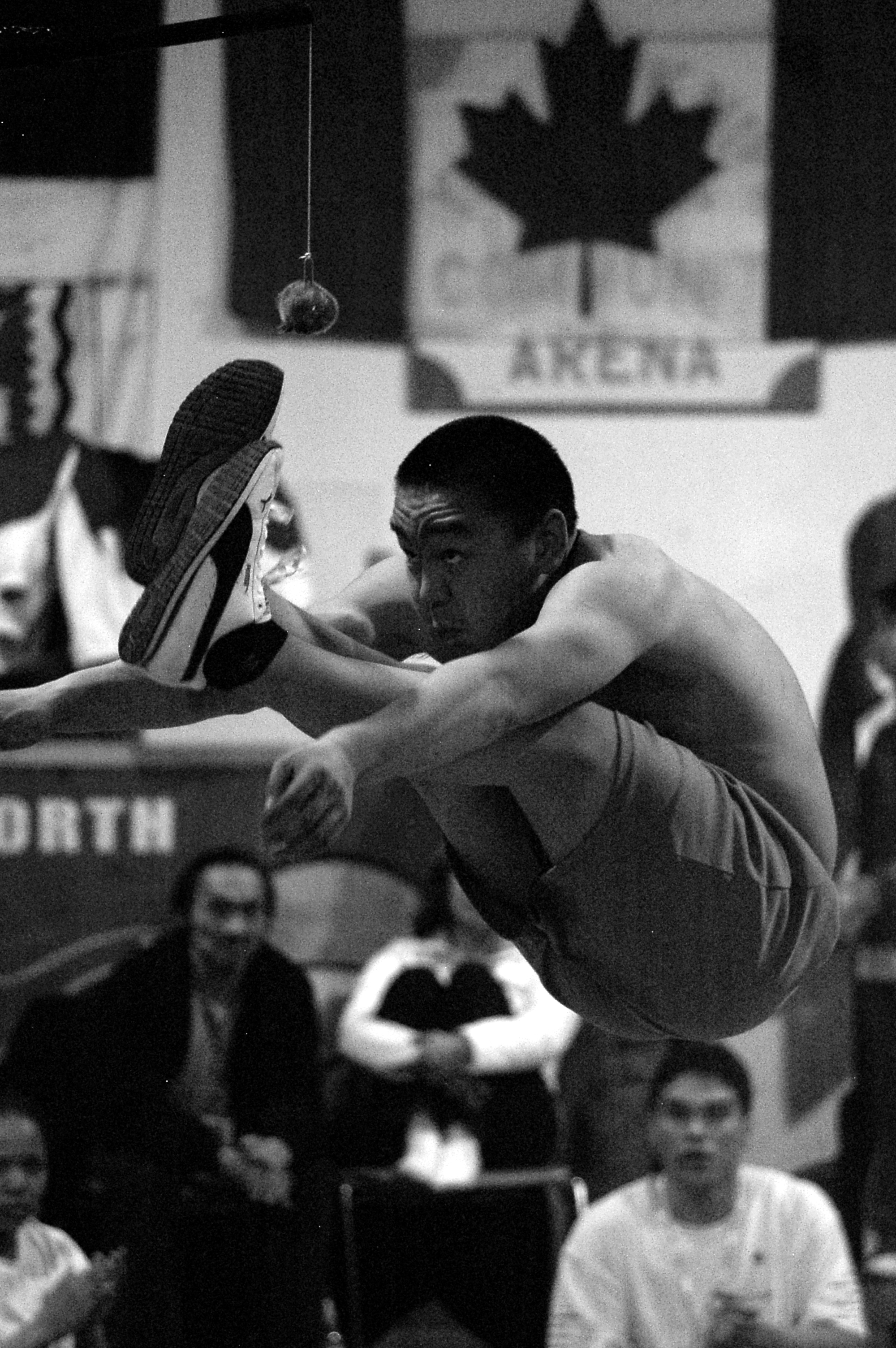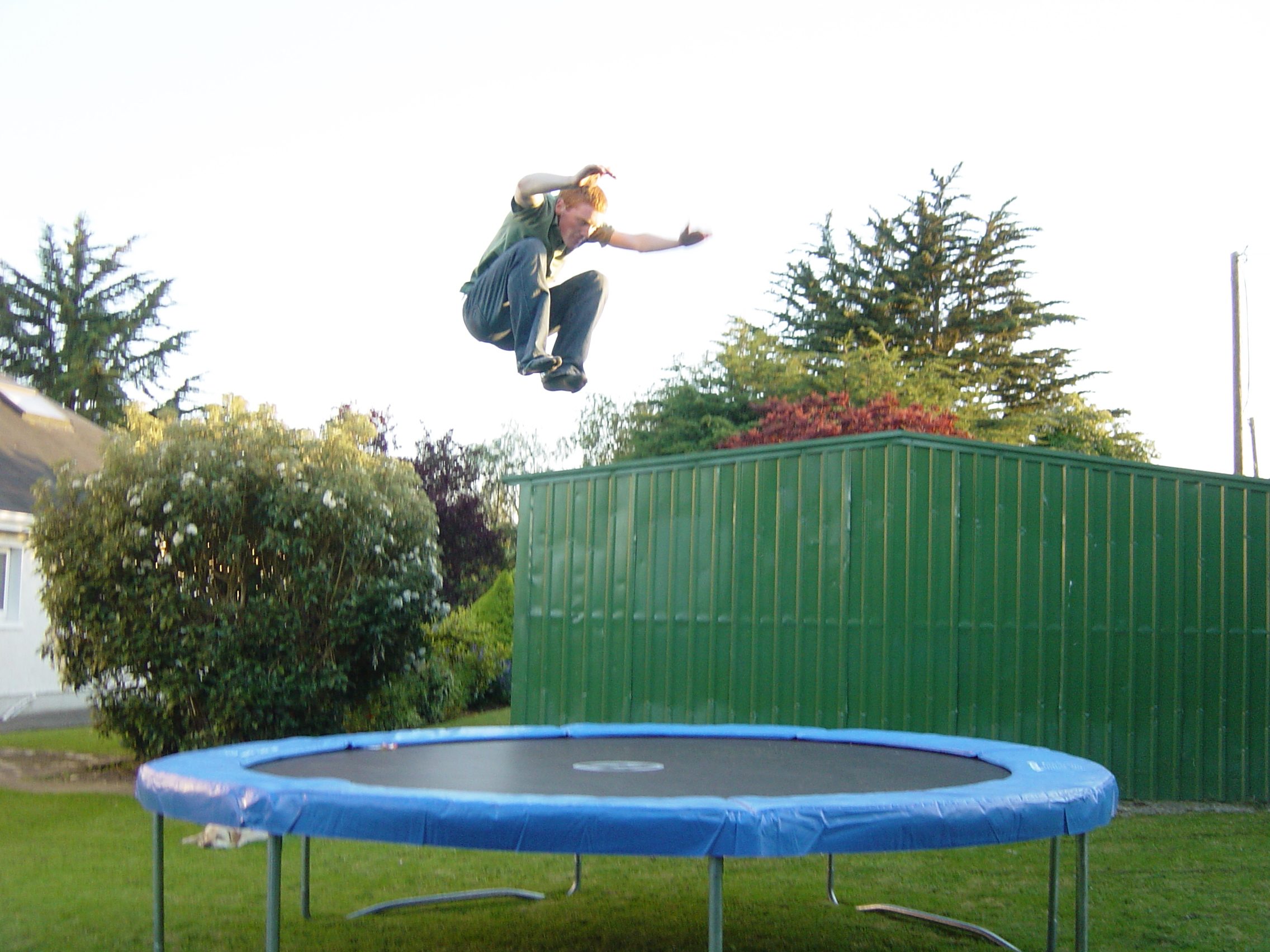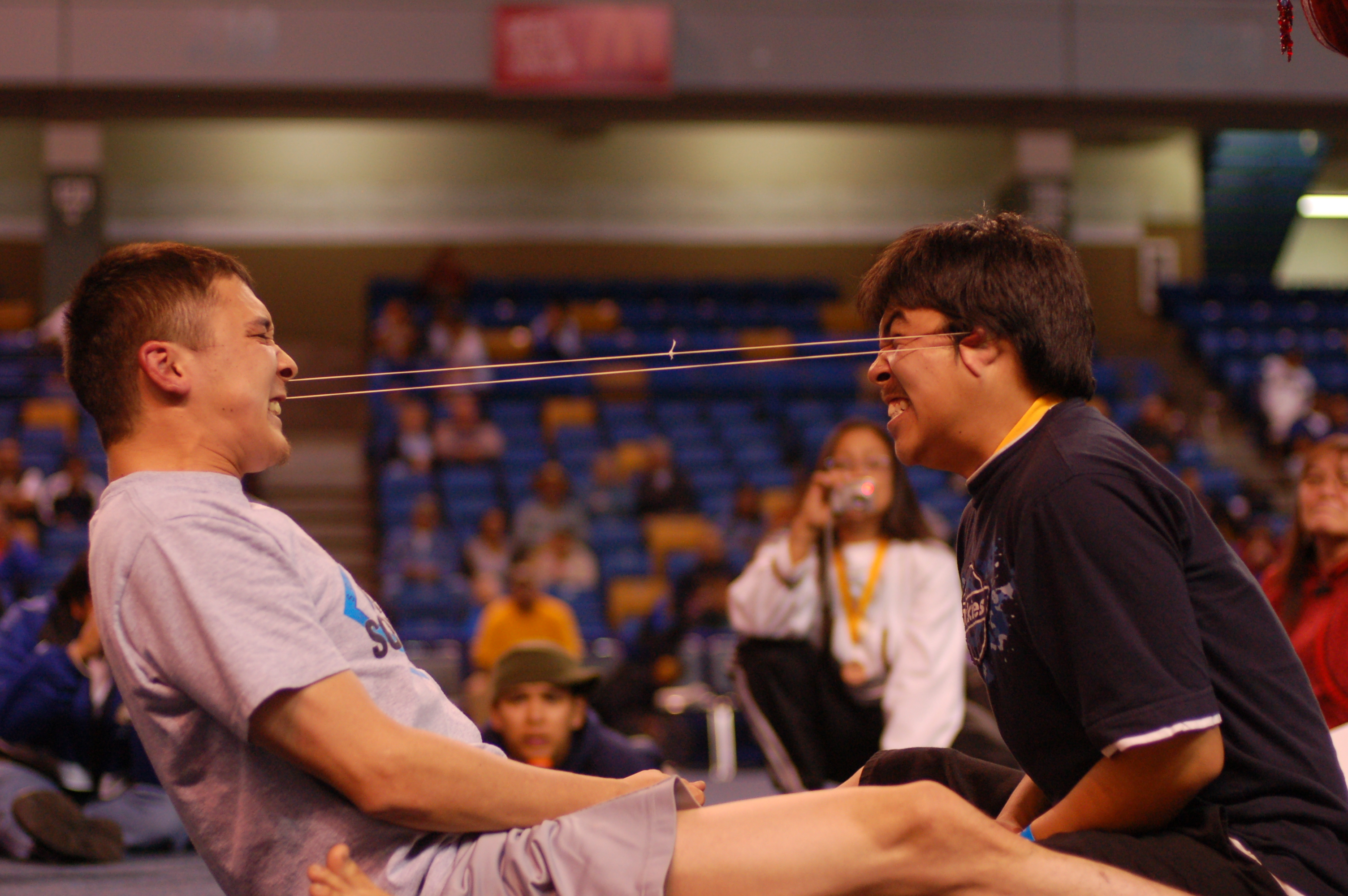|
World Eskimo Indian Olympics
The World Eskimo-Indian Olympics (or WEIO) is an annual multi-sport event held over a four-day period beginning the 3rd Wednesday each July, designed to preserve cultural practices and traditional (survival) skills essential to life in circumpolar areas of the world. The WEIO features games or sports rooted in ancestral hunting and survival techniques employed by the Inuit, Iñupiat, Yupik, and other Native Americans, as well as dance storytelling competitions, and an annual cultural pageant, called Miss WEIO, that focuses on cultural knowledge. History WEIO began in 1961 as the World Eskimo Olympics and was initially held on the banks of the Chena River in downtown Fairbanks, Alaska, in conjunction with the Golden Days celebration festivities. The event was sponsored by the City of Fairbanks, through the city's Chamber of Commerce. In 1970, sponsorship of the event was transferred to the statewide newspaper ''Tundra Times'' and several revisions were made. This includes the n ... [...More Info...] [...Related Items...] OR: [Wikipedia] [Google] [Baidu] |
Multi-sport Event
A multi-sport event is an organized sporting event, often held over multiple days, featuring competition in many different sports among organized teams of athletes from (mostly) nation-states. The first major, modern, multi-sport event of international significance was the Olympic Games, first held in modern times in 1896 in Athens, Greece and inspired by the Ancient Olympic Games, one of a number of such events held in antiquity. Most modern multi-sports events have the same basic structure. Games are held over the course of several days in and around a "host city", which changes for each competition. Countries send national teams to each competition, consisting of individual athletes and teams that compete in a wide variety of sports. Athletes or teams are awarded gold, silver or bronze medals for first, second and third place respectively. Each game is generally held every four years, though some are annual competitions. History The Ancient Olympic Games, first held in 776 ... [...More Info...] [...Related Items...] OR: [Wikipedia] [Google] [Baidu] |
Board Member
A board of directors (commonly referred simply as the board) is an executive committee that jointly supervises the activities of an organization, which can be either a for-profit or a nonprofit organization such as a business, nonprofit organization, or a government agency. The powers, duties, and responsibilities of a board of directors are determined by government regulations (including the jurisdiction's corporate law) and the organization's own constitution and by-laws. These authorities may specify the number of members of the board, how they are to be chosen, and how often they are to meet. In an organization with voting members, the board is accountable to, and may be subordinate to, the organization's full membership, which usually elect the members of the board. In a stock corporation, non-executive directors are elected by the shareholders, and the board has ultimate responsibility for the management of the corporation. In nations with codetermination (such as Germ ... [...More Info...] [...Related Items...] OR: [Wikipedia] [Google] [Baidu] |
Arctic Winter Games
The Arctic Winter Games is a biennial multi-sport and indigenous cultural event involving circumpolar peoples residing in communities or countries bordering the Arctic Ocean. Background The Arctic Winter Games were founded in 1969 under the leadership of Governor Walter J. Hickel of Alaska, Stuart M. Hodgson, Commissioner of the Northwest Territories, and Yukon Commissioner James Smith. The idea to "provide a forum where athletes from the ''circumpolar North'' could compete on their own terms, on their own turf" came from Cal Miller, an advisor with the Yukon team at the 1967 Canada Winter Games. In 1970 in Yellowknife, Canada, 500 athletes, trainers and officials came together for the first Arctic Winter Games. The participants came from the Northwest Territories, Yukon and Alaska. Since then, the Games have been held on fifteen occasions in different places and with ever more participants from more and more places within the Arctic region. The games in 2002 were the firs ... [...More Info...] [...Related Items...] OR: [Wikipedia] [Google] [Baidu] |
Muktuk
Muktuk (transliterated in various ways, see below) is a traditional food of the peoples of the Arctic, consisting of whale skin and blubber. It is most often made from the bowhead whale, although the beluga and the narwhal are also used. It is usually consumed raw, but can also be eaten frozen, cooked, or pickled. Methods of preparation In Greenland, muktuk (''mattak'') is sold commercially to fish factories, and in Canada (''muktaaq'') to other communities. When chewed raw, the blubber becomes oily, with a nutty taste; if not diced, or at least serrated, the skin is quite rubbery. One account of a twenty-first century indigenous whale hunt describes the skin and blubber eaten as a snack while the rest of the whale meat is butchered ( flensed) for later consumption. When boiled, this snack is known as ''unaaliq''. Raw or cooked, the blubber and skin are served with HP sauce, a British sweet and sour condiment. Muktuk is occasionally finely diced, breaded, deep fried, an ... [...More Info...] [...Related Items...] OR: [Wikipedia] [Google] [Baidu] |
Skinning
Skinning is the act of skin removal. The process is done by humans to animals, mainly as a means to prepare the meat beneath for cooking and consumption, or to harvest the skin for making fur clothing or tanning it to make leather. The skin may also be used as a trophy or taxidermy, sold on the fur market, or, in the case of a declared pest, used as proof of kill to obtain a bounty from a government health, agricultural, or game agency. Two common methods of skinning are open skinning and case skinning. Typically, large animals are open skinned and smaller animals are case skinned. Skinning, when it is performed on live humans as a form of torture, murder or capital punishment Capital punishment, also known as the death penalty, is the state-sanctioned practice of deliberately killing a person as a punishment for an actual or supposed crime, usually following an authorized, rule-governed process to conclude that ..., is referred to as '' flaying''. Skinning ... [...More Info...] [...Related Items...] OR: [Wikipedia] [Google] [Baidu] |
Sealskin
Sealskin is the skin of a seal. Seal skins have been used by aboriginal people for millennia to make waterproof jackets and boots, and seal fur to make fur coats. Sailors used to have tobacco pouches made from sealskin. Canada, Greenland, Norway, Russia and Namibia all export sealskin. It was traditionally used to make Scottish sporrans. The Inuit, a group of people indigenous to North America, argue that banning both seal products and seal hunting is detrimental to their way of life and the Inuit culture. However, many non-Inuit object to the use of seal skin, fur and pelts, and it is illegal to hunt seals in many countries, particularly young seals. The value of global sealskin exports in 2006 was over CA$16 million. Pinseal is the term for sealskin leather Leather is a strong, flexible and durable material obtained from the tanning, or chemical treatment, of animal skins and hides to prevent decay. The most common leathers come from cattle, sheep, goats, equine ... [...More Info...] [...Related Items...] OR: [Wikipedia] [Google] [Baidu] |
Blanket Toss
A trampoline is a device consisting of a piece of taut, strong fabric stretched between a steel frame using many coiled springs. Not all trampolines have springs, as the Springfree Trampoline uses glass-reinforced plastic rods. People bounce on trampolines for recreational and competitive purposes. The fabric that users bounce on (commonly known as the "bounce mat" or "trampoline bed") is not elastic itself; the elasticity is provided by the springs that connect it to the frame, which store potential energy. History Early trampoline-like devices A game similar to trampolining was developed by the Inuit, who would toss blanket dancers into the air on a walrus skin one at a time (see Nalukataq) during a spring celebration of whale harvest. There is also some evidence of people in Europe having been tossed into the air by a number of people holding a blanket. Mak in the Wakefield Mystery Play '' The Second Shepherds' Play'', and Sancho Panza in ''Don Quixote'', are both su ... [...More Info...] [...Related Items...] OR: [Wikipedia] [Google] [Baidu] |
Nalukataq
Nalukataq (, ''naluk-'' 'to throw it underhand; to toss it up' + ''kataq'') is the spring whaling festival of the Iñupiat of Northern Alaska, especially the North Slope Borough. It is characterized by its namesake, the dramatic Eskimo blanket toss. "Marking the end of the spring whaling season," Nalukataq creates "a sense of being for the entire community and for all who want a little muktuk or to take part in the blanket toss....At no time, however, does Nalukataq relinquish its original purpose, which is to recognize the annual success and prowess of each ''umialik'', or whaling crew captain....Nalukataq raditionshave always reflected the process of survival inherent in sharing...crucial to...the Arctic." After the spring whale hunting season, successful crews celebrate with a Nalukataq festival. Associated with the summer solstice, these take place in June and are scheduled to avoid conflicts between villages in order to allow friends and relatives from distant communities ... [...More Info...] [...Related Items...] OR: [Wikipedia] [Google] [Baidu] |
Tug Of War
Tug of war (also known as tug o' war, tug war, rope war, rope pulling, or tugging war) is a sport that pits two teams against each other in a test of strength: teams pull on opposite ends of a rope, with the goal being to bring the rope a certain distance in one direction against the force of the opposing team's pull. Terminology The ''Oxford English Dictionary'' says that the phrase "tug of war" originally meant "the decisive contest; the real struggle or tussle; a severe contest for supremacy". Only in the 19th century was it used as a term for an athletic contest between two teams who haul at the opposite ends of a rope. Prior to that, ''French and English'' was the commonly used name for the game in the English-speaking world. Origin The origins of tug of war are uncertain, but this sport was practised in Cambodia, ancient Egypt, Greece, India and China. According to a Tang dynasty book, ''The Notes of Feng'', tug of war, under the name "hook pulling" (牽鉤), was used b ... [...More Info...] [...Related Items...] OR: [Wikipedia] [Google] [Baidu] |
Ear Pull
The ear pull is a traditional Inuit game or sport which tests the competitors' ability to endure pain, and also strength. In the ear pull, two competitors sit facing each other, their legs straddled and interlocked. A two-foot-long loop of string, similar to a thick, waxed dental floss, is looped behind their ears, connecting right ear to right ear, or left ear to left ear. The competitors then pull upon the opposing ear using their own ear until the cord comes free or the opponent quits from the pain. The game has been omitted from some Arctic sports competitions due to safety concerns and the squeamishness of spectators; the event can cause bleeding and competitors sometimes require stitches. The ear pull is one example of Inuit games that "prepare children for the rigors of the arctic environment by stressing... physical strength and endurance", as well as helping one keep a mental record of one's endurance levels. References External linksVideo news reporton ear pull co ... [...More Info...] [...Related Items...] OR: [Wikipedia] [Google] [Baidu] |
3rd Toss, 2011 World Eskimo Indian Olympics
Third or 3rd may refer to: Numbers * 3rd, the ordinal form of the cardinal number 3 * , a fraction of one third * 1⁄60 of a ''second'', or 1⁄3600 of a ''minute'' Places * 3rd Street (other) * Third Avenue (other) * Highway 3 Music Music theory *Interval number of three in a musical interval **major third, a third spanning four semitones **minor third, a third encompassing three half steps, or semitones **neutral third, wider than a minor third but narrower than a major third ** augmented third, an interval of five semitones **diminished third, produced by narrowing a minor third by a chromatic semitone *Third (chord), chord member a third above the root *Degree (music), three away from tonic ** mediant, third degree of the diatonic scale **submediant, sixth degree of the diatonic scale – three steps below the tonic **chromatic mediant, chromatic relationship by thirds * Ladder of thirds, similar to the circle of fifths Albums *''Third/Sister Lovers'' ... [...More Info...] [...Related Items...] OR: [Wikipedia] [Google] [Baidu] |
Two Foot High Kick, 2009 World Eskimo Indian Olympics
2 (two) is a number, numeral and digit. It is the natural number following 1 and preceding 3. It is the smallest and only even prime number. Because it forms the basis of a duality, it has religious and spiritual significance in many cultures. Evolution Arabic digit The digit used in the modern Western world to represent the number 2 traces its roots back to the Indic Brahmic script, where "2" was written as two horizontal lines. The modern Chinese and Japanese languages (and Korean Hanja) still use this method. The Gupta script rotated the two lines 45 degrees, making them diagonal. The top line was sometimes also shortened and had its bottom end curve towards the center of the bottom line. In the Nagari script, the top line was written more like a curve connecting to the bottom line. In the Arabic Ghubar writing, the bottom line was completely vertical, and the digit looked like a dotless closing question mark. Restoring the bottom line to its original horizonta ... [...More Info...] [...Related Items...] OR: [Wikipedia] [Google] [Baidu] |






_hispida_(Ringed_seal)_fur_skin.jpg)


